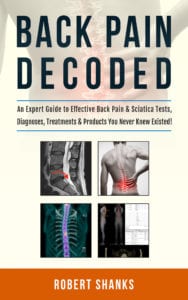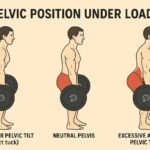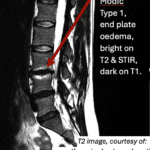IMPORTANT ADVICE & MEDICAL DISCLAIMER: We make every effort to present safe industry recognised exercises, designed to improve neck function, help and prevent pain and injury. If however any of these exercise cause pain or exacerbate symptoms you are advised to refrain and seek professional advice. It is impossible for this type of generic advice to be 100% complete, safe and effective in individual cases. Each person’s symptoms, injury and recovery can vary greatly depending on medical history, posture, genetics, motivation and application. Generalised rehabilitative and preventative exercises such as those set out below are NO SUBSTITUTE for personal, one to one consultation with an appropriately qualified health care professional.
Deep Cervical Flexor (Longus Colli) Exercise:
2 sets of 10 reps (5 sec holds)
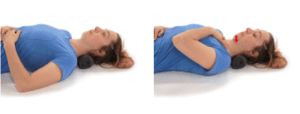
Lie on your back, knee bent, with a small towel rolled under the hollow of your neck. Place your hand across the front of your neck just above your collarbone to monitor unwanted activity of the surface muscles. Place your tongue on the roof of your mouth, with your jaw relaxed. Keep your neck still and only flex the head as if you were nodding or making a double chin, try to keep the back of your head in contact with the ground / pillow. Go as far as you can go without the surface muscles tightening under your fingers. Hold for the time instructed and then return to the starting position. Do not lift the head up off the ground, or push the back of the head into the pillow. The neck should flatten a bit against the towel roll.
Isometric Neck Rotation Exercise:
2 sets of 10 reps (10 sec holds)

Stand or sit with your back straight and your chin tucked in. Place one hand on your cheek bone to resist the rotation movement of the head (looking over your shoulder). Hold for the instructed time then slowly release the pressure and repeat. Be sure to repeat for the other side, placing one hand on the other cheek and resisting rotation.
Isometric Neck Side Bending Exercise:
2 sets of 10 reps (10 sec holds)

Stand or sit tall with your chin tucked in. Place two fingers on the side of your head. Without allowing any movement, attempt to tilt your head sideways against the resistance of your hand. Hold for the instructed time then slowly release the pressure and repeat. Be sure to repeat for the other side, placing one hand on the other cheek and resisting side bending.
Lying Head Rotation Exercise:
1 sets of 6 reps to each side
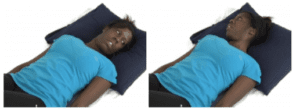
Lie on your back, knees bent, with your head supported on a pillow. Slowly rotate your head to one side as far as you can without any pain, then return to the midline and repeat in the opposite direction. The movement should be pain free at all times. Breathe out as you rotate and breathe back in as you return to midline.
Upper Trapezius / Levator Scapulae Stretch Exercise:
2 sets of 1 rep (20-30 sec hold)

Place one hand behind your buttock as if reaching into your back pocket, to lower your shoulder.
Turn your head to the opposite side and look down. Gently pull down on your head with the other hand and hold the position when you feel a stretching sensation in neck / shoulder. Repeat for the other side.
Whether your are looking for neck pain exercises, to improve posture and flexibility or to strengthen your neck the goal of any neck exercise routine should be to incorporate all these elements.
Neck strengthening exercises, particularly those that target the deep neck muscles (such as Longus Colli) and which have a stabilising affect on the cervical vertebrae are an essential part of any neck pain rehab and neck pain prevention program. Multiple studies have demonstrated the importance of Longus Colli in particular and it’s role in joint position sense (proprioception) and neck stability. However, isolated neck strengthening exercises on their own without thought or attention to actively promoting good posture and alignment of the neck is likely to lead to undue wear and tear on the ligaments, joints and discs of the cervical spine (neck).
Similarly if the muscles and joints of the neck are allowed to become to become too stiff and inflexible this can not only be a source of pain but also lead to asymmetry of movement between the vertebral segments of the neck. It should be appreciated that from the base of the scull (occipitoatlantal joint) to the C7 vertebra (where the neck meets the thorax / shoulders) your neck is constructed of 8 articulating joint segments, each segment is designed to take a certain portion of movement. If any particular segments become too stiff, not only could this reduce the amount of healthy articulation and circulation to these segments but it could also cause over compensation in adjacent segments and for them to become too mobile, thereby leading to these hyper-mobile segments suffering undue wear and tear over time.
The sample neck exercises set out above have been designed to improve neck strength and stamina, neck posture, neck movement and flexibility. With regards to posture it should be noted that adverse neck posture (such as forward head posture) is often related to altered posture in the middle (thoracic spine) and lower back so you may wish to look at our other exercise protocols.
ACKNOWLEDGEMENT: The Images above are reproduced from our software subscription to Physiotec.org. which enables bespoke exercise prescription and video illustrations for our clients, for your bespoke rehab exercise program, get in touch with one of our clinics.
 Designed and prepared By Robert Shanks, BSc (Hons) Ost, author BACK PAIN DECODED (available from Amazon and from inuryfitpro.com). Robert has been involved in the Fitness and Physical Therapy Industry for over 20 years, he is co-founding director of Spine Plus Osteopathy & Physiotherapy clinics spineplus.co.uk.
Designed and prepared By Robert Shanks, BSc (Hons) Ost, author BACK PAIN DECODED (available from Amazon and from inuryfitpro.com). Robert has been involved in the Fitness and Physical Therapy Industry for over 20 years, he is co-founding director of Spine Plus Osteopathy & Physiotherapy clinics spineplus.co.uk.

